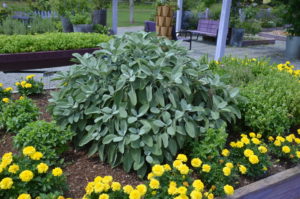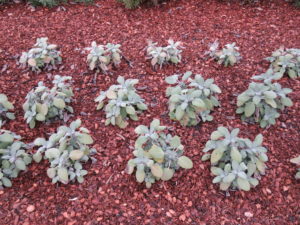Common sage (Salvia officinalis), a member of the mint family (Lamiaceae), is the culinary sage familiar to most cooks (USDA hardiness zones 5 to 8). The species grow 1.5 – 3 feet high and wide. Multitudes of showy two-lipped, 1-inch long, violet-blue flowers arise on short, upright spikes in late spring. Flowers attracts numerous bees and butterflies.
The cultivar ‘Berggarten’ is a compact perennial form that typically grows 1-2 feet tall. Its grayish green 2-4 inch long leaves are wider than the species and strongly aromatic. Its large oval leaves are unlike that of your typical garden sages.
Berggarten salvia is a culinary delight. In southern climes (zones 8-9), foodies and gardeners alike will treasure this evergreen perennial. In early spring trim back to newly emerging growth or strong stems. Spikes of violet-blue flowers appear in early summer. Medical curative properties are also attributed to some species of the Salvia genus.
Salvias grow in average, dry to medium moisture, well-drained soil and in full sun. Leaves develop a purplish cast in full sun. They tolerate very light shade, but plants tend to grow weakly and need staking if not grown in full day sun. It tolerates alkaline soils. Poorly drained soils leads to fatal root rots.
Few serious insect or disease problems trouble Berggarten salvia if planted in the right location. The plant is tolerant of deer. Monitor the plant for powdery mildew, rust, stem rot, fungal leaf spots, whiteflies, aphids, mealybugs, spider mites. Plant and flowers attract butterflies.
Berggarten is an excellent addition to an herb or vegetable garden. Grow it also in mixed containers, in borders, or in rock gardens. Over time, plants develop a woody shrub base and is best cut back in the spring to 4 – 6 inches.



 Posted in
Posted in 
